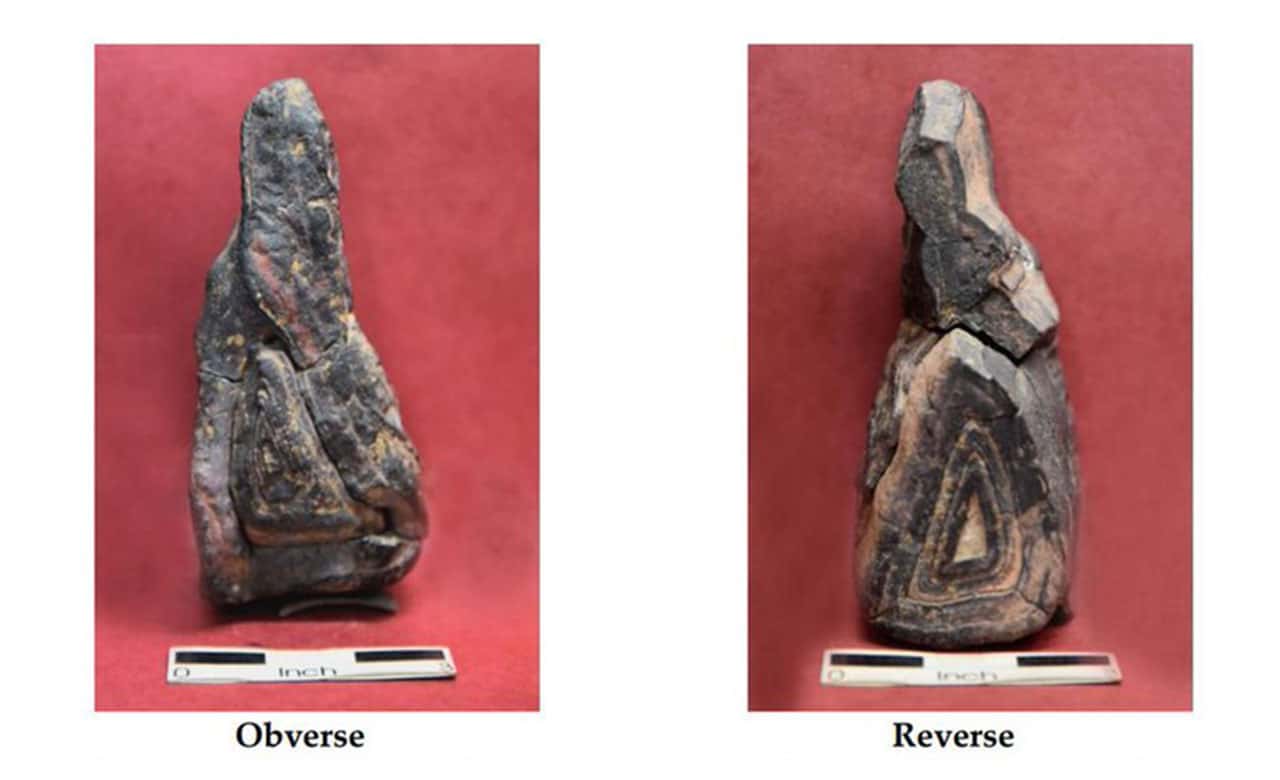
Spirituality
Baghor Stone: 11000-year-old Shakti
Son river flows through the center of India. Originating in the inaccessible hills of Amarkantak- Madhya Pradesh, it merges to Holy river Ganges, near Patna, Bihar. A small village named Medhauli, which is the home of about 350 tribal homes, lies on the banks of this river. The year was 1980, and excavation was going on with the collaboration of the University of California, Berkeley.
Archeologists found several Upper Palaeolithic stone artifacts dating about ten to thirty thousand years old. When they were digging a circular platform, they were astonished to see a particular stone, having three concentric triangular striations etched into it. This stone, containing three triangles embedded in one another, was decorated with different colors and striking patterns. This is how the world got to know about the most ancient Yantra known to man as Baghor stone.
After expanding their excavation sites further, Professor J. Desmond Clark and Professor G. R. Sharma found three more Yantras of the same kind. While discussing these findings with local tribes Kol and Baiga, they were surprised to find out that even today, the local tribes pray to the same kind of triangular stones. They call it ‘Mai,’ or, ‘Mother Goddess.’ In this blog, we are going to uncover some astonishing facts about this most ancient Yantra.
Why is the Baghor stone considered an important discovery?
It has been confirmed that Vedas were compiled during the first millennium BC, and the Tantric texts were written one thousand five hundred years ago. But the question was, how did the man from the upper paleolithic era reach the intricate science known as Tantra? The answer lies in the Baghor stone.
It has been established that findings of this Son valley excavation echo into the Indus valley civilization. Even today, the tribals are praying to the Mother Goddess, a tradition that has remained unchanged for the last eleven thousand years.
Baghor stone and Tantra
Tantra is all about honoring the sacred female energy with exquisite, feminine traditions that celebrate the Mother Goddess Shakti. Archeologists say that the symbolic worship of Shakti, the manifestation of the Divine Feminine, had its beginnings, dating back thousands of years ago, in the form of Baghor stone, when hunter-gatherers roamed this Indian subcontinent in search of food.
During those times, women had important positions in the tribes. They were honored as Goddesses who looked after the family, giving birth to the progenies, nourishing them, and protecting them from any harm. Females were responsible for making the tribes stronger, which was essential for the tribe’s survival.
Under the Tantra tradition, the Divine feminine is worshipped in many forms. Let’s take the example of Divine Mother Kamakhya, located in Assam, where the Shakti is celebrated as a menstruating Goddess. Few archaeologists believe that the triangular-shaped Baghor stone is a symbolic representation of Yoni, a female reproductive organ, and is prayed as one form of Shakti.
The further excavation went on, and at the end of the excavation in 1982, archaeologists found a praying platform. The platform was covered with sandstone rubble and some half-made tools. The colorful stone, with three triangles embedded in each other, was found among this rubble, just like the first one they found two years before.
Village Kerai was located about one kilometer from the excavation site, home to the Mother Goddess Korai Devi. The shrine of Kerai Devi can be seen even today, and she is considered the protector of the Kerai village, and villagers pray to her for the blessings of the children. Apart from the six triangular-shaped stones with different colors, the shrine is an abode of Angari Devi, a deity without a head. Divine Mother Angari is considered as the deity of burning coal or the one which provides warmth.
All six Yantra stones, along with Angari Devi, are smeared with vermillion, and tribal seekers present locks of hair and coconut to their Divine Goddess. They genuinely believe that Goddess bestows health, prosperity, and protection upon villagers. This live shrine of Divine Mother Kerai allows us to travel eleven thousand years back in time and to experience the Divinity of these ancient Goddesses.
The ancient Baghor stone signifies how deeply rooted the Tantra was in the Indian subcontinent. Even though it is considered that the Tantra worship has begun to acquire shape during the last two thousand years, the occurrence of this ancient geometrical diagram shows us that Tantra might be even more ancient than we thought.
We hope this blog helped you get some information on the most ancient Yantra- a Baghor stone.
To stay connected and to receive information about spirituality, please subscribe to our mailing list. In case of any queries, please write to us at info@chamundaswamiji.com.
Post a Comment
-
Subscribe to Our Blog
-
Categories
-
Popular Articles
- Dead moth in the house. What universe is trying to tell you?
- Spiritual Meaning of Moth
- Vivah Bandhan Curse – What Is It and How to Spiritually Heal It.
- What are Beej Mantras?
- The Dasa Mahavidyas
- Tripura Sundari | The Dasa Mahavidya
- Maa Bhuvaneshwari | The Dasa Mahavidyas
- Ramakrishna Paramhansa – The Man who almost became a Woman
- The Five Shades of Tantra
- Maa Chinnamasta | The Dasa Mahavidyas



